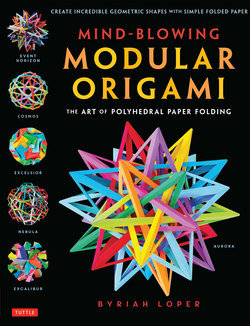Читать книгу Mind-Blowing Modular Origami - Byriah Loper - Страница 5
На сайте Литреса книга снята с продажи.
ОглавлениеPREFACE
ORIGAMI, the Asian art of paper folding, has long been seen as an expressive, representative art focused on modeling real-life objects in paper.
From simple airplanes and frogs to highly detailed, lifelike insects and dragons, origami has expanded greatly in the past half-century. New techniques have led to greater complexity, detail, and technical design. During that time, the boundaries of origami have expanded into new concepts, including modular origami.
MODULAR ORIGAMI has most of the same rules as traditional origami, but comprises the folding of multiple pieces of paper into individual units or modules, which are then assembled together to make a single model, generally without the use of any adhesives. Each unit is held to the others strictly by the tension of the paper, and the resulting models cannot be replicated with just a single piece of paper. Modular origami is a wonderful testimony to the remarkable hidden strength of paper, which is often regarded as being flimsy. As if by magic, hundreds of pieces of this seemingly weak material can be transformed through folding in such a way as to create magnificent three-dimensional structures without the use of any adhesives or cutting. The resulting forms can be surprisingly strong, lasting for years.
Like traditional representative designs, modular origami began very simply. In the 1970s, Mitsunobu Sonobe’s development of the Sonobe unit expanded origami to new horizons. This simple universal unit, capable of being assembled into a number of basic geometric polyhedra, paved the way for numerous variations and new designs over the next decades. Tomoko Fuse, Tom Hull, Robert Neale, Miyuki Kawamura, Daniel Kwan and many others designed increasingly sophisticated constructions; the complexity, innovation and artistry of modular forms has continued to grow. There are thousands of models in existence now, with new designs appearing regularly.
Modular origami isn’t limited to polyhedra—flat stars, coasters, tessellated quilts and even representative models have been made with more than one piece of paper—but it was the polyhedral modulars that first caught my attention when I began folding seven years ago. From starkly geometric models that are hardly more than paper representations of polyhedra to embellished floral spheres so ornate that they seem to have no mathematical basis whatsoever, the symmetry and form that they held attracted me. The repetition of folding the individual units may be tedious, but I have always held that the satisfaction found in the assembly process makes the labor worthwhile. I might never have pursued modular origami beyond a minor hobby, however, had I not discovered the larger origami community online, and with it, a particular type of modular generally referred to as a Wire Frame. This category, which includes the most complex and exciting models in modular origami, gave me a renewed interest in this art that has remained with me ever since, and as such, is the focus of this book.
Though I will define it in greater detail later in the book, the term “Wire Frame” describes any intersecting, interlocking or interwoven origami compound, or any model based on the basic “edge unit” which is nearly always used to form the edges of a polyhedron. With these models, the folding of the individual units is invariably much easier than the assembly process. Once I discovered Wire Frames, I folded all that I could find and then started designing my own. Since then, I have designed a great number of these models, and have often been asked to explain how they were made. While several others have diagrammed Wire Frames before, there is no volume devoted primarily to the explanation of these models. So when the opportunity arose to write a book, I took it as an occasion to help share and explain these geometric origami constructions in a way that could be most easily understood.
While a basic understanding of geometry is helpful, very little knowledge is necessary to begin. With knowledge of the different types of polyhedra and polygons, along with a little experience, you should be able to create all the models in this book, and perhaps even some variations of your own. I selected seven simpler, more embellished modular creations to serve as a basis for the twelve more complicated Wire Frames that follow. If you aren’t familiar with modular origami, I suggest starting with the more basic models and getting practice with them until you have gained enough confidence to try the more complicated constructions.
I enjoy designing Wire Frames, and consider them to be the pinnacle of technical modular evolution. With extremely simple units, some remarkably difficult and complicated structures can be made with only paper and the use of your hands. The weaving process is always exciting and challenging. The finished work is a visually stimulating piece that requires more than a passing glance to appreciate. Wire Frame models are akin to geometric puzzles that you must create and then solve using only folded pieces of paper. Like the more complicated representative models, Wire Frames may take more time to assemble than some regular decorative modulars, but the extra effort is apparent in the result.
I have folded and designed all kinds of origami, but have always returned to modular origami, as it is my favorite style. I hope that this book gives you a greater appreciation for the stark geometric beauty and dynamism of modular origami.
